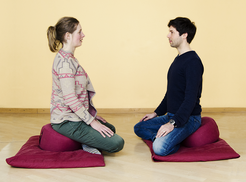“Mental training to become a tolerant global citizen”
Tania Singer, director at the Max Planck Institute for Human Cognition and Brain Sciences, talks about mental empathy exercises, our inner judge and prospects for peaceful coexistence
For the past ten years, a team led by Tania Singer at the Max Planck Institute for Human Cognitive and Neurosciences has been investigating the effects of meditation on behaviour and associated changes in the brain in a large-scale study, the ReSource project. The study is not only providing new insights into classical meditation techniques but is also complementing them with new mental training techniques.

Ms Singer, why have you developed new forms of meditation?
I was specifically looking for a way to teach subjects social skills such as compassion, empathy and what is known as the theory of mind. Theory of mind means, to put it succinctly, the ability to understand the thoughts, beliefs and opinions of others.
There are also classical meditation techniques to increase compassion, such as the meditation of loving kindness. In this approach, the individual directs sympathetic thoughts to others during meditation. But the practitioner only imagines his or her counterpart, which makes it all rather difficult. I therefore thought that it would be better to also use partner exercises, as done in some therapies. We called the exercises contemplative dyads because they are like vocal meditation in pairs.
Could you explain what a dyad is?
You could think of it as meditation with a witness: one person speaks and the other listens quietly, while feeling empathetic or trying to put themselves in the mind of the speaker, depending on the type of dyad. Then they switch roles.
We’ve developed two different forms. In the first, more emotionally oriented, module, the participants report a difficult situation that they experienced that day and how they perceived it physically. For example they may have had moist palms or heart palpitations. Then, as a contrast, they describe a situation in which they experienced gratitude and their physical response to it, such as calmer breathing or more relaxed muscles. Then it is the turn of the partner who was listening to tell his or her story.
For three months the partners did these dyadic exercises every day for ten minutes from home using a phone app to allow them to fit the exercises into their daily routine. Each week the partners changed within the experimental group. The exercises were not about establishing relationships but about learning that stress and gratitude can be felt and that we are all alike in this respect.
How does the second form of partner-paired meditation differ?
The second module is more cognitive in orientation. It’s about learning to change perspectives, either of oneself or of others. The basis for these perspective dyads, the daily partner-based exercise in this module, is the model of the internal family system developed by Dick Schwartz. We all have certain personality parts such as the inner child, the protector and the inner judge. The judge, for example, is the one who causes stress by telling us that we have not lived up to expectations.
The dyads in this module are about relating a situation that a subject has just experienced from the perspective of one of these personality parts. The perspective to be assumed is determined by a computer. The listening partner in the exercise doesn’t know which personality part is speaking. He or she tries to enter the thoughts of the other while listening in order to surmise at the end of the exercise which personality part was speaking.
However, these ten-minute dyads made up only a part of the two social modules: affect and perspective. In both modules, the subjects were asked to practise a classical core meditation exercise for 20 minutes on their own as well. In addition, other forms of meditation whose content complemented the respective modules were introduced during the weekly sessions with the instructors.

Were you able to observe an effect of the training?
More than one! If you ask a sports scientist whether sport has a training effect, he or she, in turn, will first ask you: What kind of sport do you mean? Do you mean swimming or football or maybe chess? Meditation is a bit like muscle training for the mind: the effect depends on the kind of mental exercises you do every day. That’s why we developed the three different training modules. As expected, each module had very specific effects, for example, a change in the structure of specific brain networks concerned with attention, compassion or perspective-taking.
How easy is it to measure the training effects of meditation?
This kind of research is not easy. But we’ve developed measuring methods that allow us, for example, to detect changes in empathy, compassion and the theory of mind in a scanner and on a behavioural level. With these tests, we were actually able to show that the subjects’ skills had improved in line with their training module after three months. Moreover, this was accompanied by structural brain plasticity in the neural networks concerned.
For example, the first presence module for mindfulness and awareness actually improved the subjects’ ability to concentrate. As suspected, the socio-affective module improved their ability to sympathize with others. And the socio-cognitive module enhanced their ability to assume the perspective of others.
In addition, we used magnetic resonance tomography to measure structural changes in the subjects’ brains before and after the three training modules. Here too, we were able to show that each module resulted in specific structural changes in the brain that underlie the processing of awareness, compassion or perspective-taking. In this way, we were able to demonstrate for the first time that the social brain of adults, who were over 40 years old on average in our study, is still plastic.
According to your measurements, your training methods also help to reduce stress. How’s that?
Stress is a complex phenomenon. In our Western societies, social stress in particular has become a huge problem. Social stress is triggered when we are afraid of being judged negatively by others and not meeting their expectations. We were able to show that social stress – that is, the response of the stress hormone cortisol to a social stressor – was reduced by almost half, especially by the two social training modules − affect and perspective − but not by the mindfulness-based presence module.
This makes sense, because in the partner exercises I mentioned, the contemplative ten-minute daily dyads, I experience every day that someone is listening without judging me. In other words, every day I practise reducing the fear of censure by others. Our hypothesis is that this is the reason why the two social training modules are so effective.
Many people may find it surprising that, contrary to prior assumptions, the classical mindfulness-based meditation exercises such as the body scan or classical breathing meditation in the presence module, which form the basis of many conventional mindfulness-based stress-reduction programmes, does not influence social stress at the hormonal level after three months of exercise. However, nowadays such basic exercises are often propagated via an app or short programmes, and many clinics offer such exercises to alleviate stress symptoms in patients.
In fact – and we also found this in our study by asking the subjects to complete post-exercise questionnaires – they felt subjectively less stressed after all three modules, including the mindfulness-based presence modules. However, we also showed that these kinds of mindfulness-based basic meditation exercises alone do not reduce the cortisol response to a social stressor. Therefore, if you want to be less susceptible to social stress, you need to train your intersubjective skills.
So the subjects benefited significantly from your study?
We’ve also received feedback on that. Half the subjects in our study actually continued to the programme on their own after the training had ended. I know of one group that still practises dyads every day some two and a half years down the line. To my mind, that is at least as important as the data we obtained.
Your approach to improving empathy and compassion comes just at the right time, when you consider that hate and harassment are becoming increasingly widespread. Could your methods counter this trend?
Of course it will not solve fundamental social problems. But such mental empathy training can significantly expand the circle of those I feel compassion and understanding for. It teaches basic skills that everyone needs in order to become responsible, tolerant global citizens.
I could imagine, for example, that such exercises could be particularly helpful in problem schools in which many cultures come together and where the ability to take others’ points of view and to deal with stress and difficult emotions is very important. If the children and adolescents there were to train regularly, that would certainly have an enormous effect, not least of all because children’s brains are by nature much more plastic than those of adults.
mez













